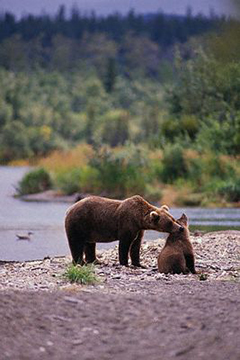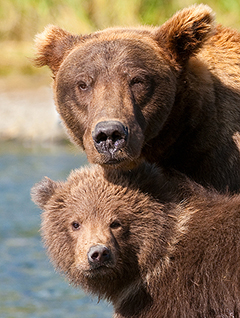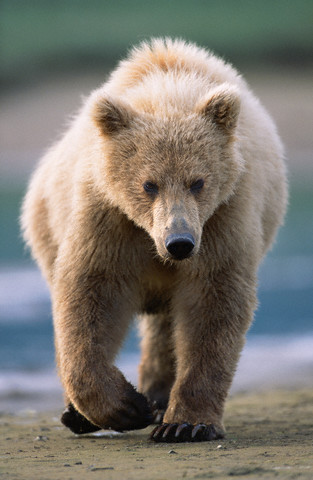|
Silver Salmon Creek Lodge is a premier vacation destination for wildlife photography, world-class sport fishing and Alaska bear viewing. Under the same management since 1983, hosts David and Joanne Coray welcome all national and international guests. The lodge offers its patrons a sense of Alaska adventure with all of the upscale amenities as well. The lodge has developed into one of the premier sites in Alaska to view Brown Bears in their natural environment. Our knowledgeable guides assist our guests in getting properly positioned for excellent viewing, understand behavioral nuances and gain key information about bear biology. Bear viewing packages are offered from June through mid-September.At Silver Salmon Creek Lodge Alaska bear viewing, other wildlife, landscape, and outdoor opportunities combine to offer visitors a true sense of Alaskan wilderness. Towering volcanic mountains form an immediate backdrop to the tidal marshes, streams and pristine salt-water bays which comprise the coastline of Lake Clark National Park. |
Lake Clark | Silver Salmon Creek Lodge Bear Viewing Tours
Tour Itinerary
Lake Clark National Park FAQ
|
Day
01 |
 |
Silver Salmon Creek Lodge | Tours Because it is one of the first streams in the region where bright, energetic, and pre-spawned salmo Wildlife Enthusiasts will enjoy this exclusive Bear Viewing Location at the coast of Lake Clark. At Silver Salmon Creek Lodge the landscape, wildlife and outdoor opportunities combine to offer visitors a true sense of Alaskan wilderness, with towering volcanic mountains forming an immediate backdrop to the tidal marshes, streams and pristine salt-water bays which comprise the coastline. Guests can choose to fly in from Anchorage, Homer or Soldotna. Photography is a major component of our services at Silver Salmon Creek. We have developed a safe and successful program of moving into the habitat of brown bears, being careful not to disturb the free-ranging nature of their movements. No permits are needed and no viewing platforms are used. Tour leaders have chosen our facility to bring their clients, resulting in exceptional opportunities for unique images and peaceful encounters. Also of interest to photographers are nearby pelagic bird populations, including horned and tufted puffins, black-legged kittiwakes and murres. Bald eagles, trumpeter swans, and harbor seals can also be targeted on our personalized nature tours by land and sea. Scenic backdrops include volcanic Mt. Iliamna, Mt. Redoubt, and Augustine volcano, all part of Cook Inlet's "ring of fire. If you're looking for some outstanding bear viewing, Silver Salmon Creek Lodge is a great choice. The lodge has a safe and successful bear viewing program here for nearly 15 years. All guides are experienced bear guides, the bears are in their natural habitat and our unique location in Lake Clark National Park on the west side of the Cook Inlet ensures that you won't have to fight the typical crowds as on Katmai's Brooks River. You will be able to move freely about while observing safe bear viewing practices in the company of one of our well-trained guides. Our tours are particularly popular with photographers. Our lodge features a computer with digital media readers and a CD burner for use by our guests maximizing your enjoyment if you have a digital camera. We also offer a high speed internet connection in case you want to email images to your jealous friends! |
|
Day
01 |
 |
Silver Salmon Creek Lodge | Activities The lodge sits on a rare and isolated private in-holding within the coastal section of 4 million acre Lake Clark National Park and Preserve. The surrounding watersheds and marine ecosystem provide optimum habitat for five species of salmon, dolly varden, halibut and a prime location only 40 minutes away from Bristol Bay rainbow fisheries. Short, coastal rivers and creeks cascade from the surrounding Chigmit mountain range down to the remote lower west side of Cook Inlet. King salmon, chum salmon, pink salmon and red salmon are all available but perhaps the most coveted species of all is the hard fighting, aggressive silver salmon. The local rivers provide optimal conditions for what is fast evolving from a novelty to a passion within the sport. Dry fly fishing enthusiasts are flocking to Alaska to target salmon on the top water. Only a varied few watersheds throughout the state provide the conditions necessary to hook and land salmon on top water and Silver Salmon Creek is one of these rare places. Explosive and dramatic surface takes have humbled many a seasoned angler and left all yearning for more. Light tackle surface anglers are also able to take advantage of this exciting fishing with our guides providing the knowledge and skill in landing a salmon on top water. Our 25' charter boats takes anglers to offshore halibut grounds with high success rates and all gear provided. Vacuum seal machines insure your catch will be properly processed for traveling. Other activities include our popular bear viewing photography program, boat visits to nearby sea-bird rookeries, sea-kayaking, fossil exploring along an ancient Jurassic seabed, clam digging for succulent razor clams, canoeing, hiking, beach-combing or wilderness tent camping. |
|
Day
01 |
 |
Silver Salmon Creek Lodge | Bear Viewing Alaska's Cook Inlet is a popular kayaking destination, but the West side of the inlet has been out of the reach of most paddlers due to a lack of guides and facilities. Silver Salmon Creek Lodge is proud to announce the first full-service kayaking operation on the West side. Let Silver Salmon Creek be your kayaking base on the West side of Cook Inlet. We offer a variety of kayaking experiences, ranging from beginning paddles with instructor and all equipment provided to full-day trips for those with some experience and multi-day trips for those with more time. All trips away from the Lodge are guided. Full day kayaking tours through Tuxedni Bay are available in late May through early July. The wildflowers are peaking during those months and the famous Cook Inlet tides will help propel you up into the Bay where you can see a glacier as well as the towering Mt. Iliamna, one of America's largest active volcanoes. At high tides the creek and sloughs around the Lodge itself become an ideal kayaking site. They are excellent for beginning paddlers but feature plenty of scenery to keep the veteran enthusiastic. You may see a Brown Bear and cubs feeding on the grass, or a Bald Eagle scouring the shoreline for food. The menu features local seafood including salmon, halibut, clams and mussels, as well as fresh greens and herbs from our garden. Guests dine in intimate "family style" in a comfortable dining room with spectacular views of the Cook Inlet. It is not uncommon for a bear to appear on the meadow in front of the lodge during dinnertime, completing the ultimate Alaska dining experience. Meal times are flexible to accommodate guests many activities at the lodge. |
| Rates in US $ / per Person | Double |
| Bear Viewing Day Tour to Silver Salmon Creek | $1090.00 |
| 3 Days | 2 Nights Silver Salmon Creek Lodge Package | $2600.00 |
*** We recommend to book Silver Salmon Creek Lodge 2-3 years in advance ** |
Katmai National Park:
Located in southwestern Alaska, Brooks Falls is one of the best places in the world to observe brown bears. The bears and humans have been peacefully coexisting at Brooks Camp for over 30 years. There are three viewing stands set up for viewing the bears while they fish for salmon at the Brooks waterfall. However, you commonly run into bears on the trails to the observing stands and campground. The bears have learned that they can trust humans in Katmai so they pretty much pay no attention to humans and simply go about their business of non-stop eating. Katmai has the largest concentration of protected brown bears in the world and there are roughly 2,000 brown bears in the 3.6 million acre park. Unlike many other bear viewing locations in the world, the bears at Brooks Camp are protected from the grossness of sport hunters so most are not scared of humans. They are not aggressive to humans either. Brooks Camp is one of the finest examples in the world of peaceful human- and animal coexistence. It has almost a utopian feel to it. It's such a fun and exciting place to be with everyone excited about bears. The lodge has a bar, excellent food, and an indoor fire that people sit around while talking about bears and photography. Best time to visit is in July or early September. Overall, the world can learn a lot from Brooks and the national park service does an excellent job managing the camp.
You have several options for visiting Brooks. One option is to do a day trip; however, we strongly advise against it because between weather, flight delays, and bear jams (i.e. the bears frequently decide to take naps on the trail and you have to wait until they wake up) you may never even make it down to the actual falls (although I found getting to the falls to actually be more exciting than being at the falls). Also, once you see a few of these amazing bears you won't ever want to leave. If you do decide to overnight you have the option to stay in the lodge cabins (privately owned) but there are only a few so they're very difficult to actually get one. (they must be reserved at least one year in advance)
FAQ: Expert Travel Advise
How to Get There
From Anchorage, scheduled jets fly the 290 miles to King Salmon, park headquarters; from there, June to mid-September, daily floatplanes fly the last 33 miles to Brooks Camp, site of a summer visitor center and the center of activity. Air charters can be arranged into other areas. You can drive the 9 miles from King Salmon to Lake Camp, at the western end of the park on the Naknek River, then go by boat to Brooks Camp, the Bay of Islands, and other areas of Naknek Lake.
When to Go
June to early September. Only then, with transportation from between Brooks Camp and the Valley of Ten Thousand Smokes, are the lodges, cabins, and Brooks Camp Campground open. Bear watching, an increasingly popular pastime, is best in July when the sockeye salmon spawn (bear watching suffers a brief lull in June and again in August). Fishing and hiking are good throughout summer, but come prepared for rain. Heavy snowpack may remain in the upper elevations into July. Summer daytime temperatures range from the mid-50s to mid-60s; the average low is 44°F.
How to Visit
If your time is short, get to Brooks Camp. People, fish, bears, boats, and planes concentrate here. Compared to the rest of the park, it's crowded. But the lodge and campground are comfortable (reservations required) and the bear viewing unforgettable. You'll find good hiking and fishing. If at all possible, take the bus or van tour 23 miles out from Brooks Camp to the Valley of Ten Thousand Smokes. Return the same day or hike into the valley and camp. You can extend your stay by boating or flying to the many other lakes, streams, rivers, and lodges in the park. Pick your area, make a safe plan, and go.
Bear Viewing
A trail from Brooks River Lodge, about a quarter mile long, leads to a floating bridge across the Brooks River. After crossing the river, an elevated viewing stand is available for watching bears in this popular area where the river empties into Naknek Lake. Bears often approach the bridge from both land and water. If it appears that a single bear will approach within 50 yards, or a sow with cubs within 100 yards, a ranger stationed on the viewing stand will direct everyone to get off the bridge and onto the viewing stand, or to return to the trail to the lodge. Another ranger is normally stationed on the trail to prevent people from the lodge walking to the bridge when a bear is present. The gates at each end of the bridge do not keep adult bears off the bridge, but probably do keep small cubs from getting separated from their moms. A smaller gate is at the viewing stand entrance. The bridge area of the river is a popular fishing spot, and many large salmon are caught there daily. The fishermen must also move to the viewing stand if a bear approaches. If a fish is hooked and a bear approaches, the angler must break their line immediately and not land the fish. The bridge is a popular place to watch the salmon swim through the shallow water.
About 200 meters beyond the Riffle platform is the Falls viewing platform. This platform is often crowded, as shown here, and a ranger will limit the time an individual spends on the platform to about an hour during the crowded times. Crowding starts about 10 AM, and ends at mid afternoon. Each morning several floatplanes arrive with visitors that make a mid-day visit and then leave. I am guessing that 20 to 30 of these mid-day visitors arrive each day, but there could be more. About 15 people can comfortably watch bears at one time from the two levels of the Falls platform. About 20 people make it crowded. There is a covered seating area where the Riffle platform walkway joins the Falls walkway where bear watchers can wait a turn on the Falls platform. There are no toilet facilities except at the lodge.
The falls is the place everyone goes to see bears. This is the place where bears at the top of the falls catch salmon in midair as they attempt to jump up the falls to reach their spawning area. This is also the place where large males are present. Smaller males, like the light colored one at above right, keep away from the larger males. Several bears have favorite places, and they all seem to know their pecking order. At times one bear would approach another that had a fish, and the one with the fish would would either drop it, or quickly leave the water with it. Leaving the water did not always prevent the other bear from following and taking the fish, but it sometimes did.
Bear Facts
Male Brown Bears weigh 300 – 850 lbs
Female Brown Bears weigh 200 – 400 lbs
Bears usually live 20 – 25 years
Brown Bears can run up to 35 mph
Good to know if you visit Brooks Lodge
Meals are rather expensive at Brooks Lodge: Breakfast $17.00, Lunch $22.00, Dinner $35.00 (based on 2014 Information) Outdoor Clothing: Warm Jacket or Sweater, Personal Items, Walking Shoes or Boots, Sunglasses, Raincoat, Camera & Memory Cards, Long Sleeve Shirts, Mosquito Repellent should be kept with Scarf, Hat or Cap during your travel. The atmosphere at the lodge is casual, so bring comfortable medium weight sport clothes. By dressing in layers, you can add or subtract clothing and be comfortable regardless of the whim of the weather. Internet services are not available at the lodge. Trading Post Shop: The trading post offers a variety of items to purchase. Candy, freeze dried foods, soft drinks, and other snack items (trail mix, beef jerky, etc.). Personal items such as: Toothpaste, insect repellent, soap, film (no memory cards available), batteries and tobacco. Fishing items such as Line, leader, lures, flies and Alaska fishing license. You may also rent: Rods & reels, chest waders, canoes, kayaks, single burner stoves, bear resistant containers and showers and towels (for campers).
Wildlife Photography
A few suggestions to help clients preparing for wildlife photography adventures. While we all don't have the luxury of owning a super-telephoto lens of 500mm or greater, that's not a problem in most Alaska bear viewing areas. Here is a packing list to maximize your photographic flexibility while experiencing the great outdoors within Lake Clark - and Katmai National Park.
SLR Camera body
If you have a super-telephoto nothing larger than 500mm, you'll miss too many shots because you're just too close!
A 1.4 tele-convertor, a 2x will eat too much light.
The best overall lens for the bears will be a 100-400mm for Canon or a 200-400mm for Nikon.
A good substitute if you don't have either of these is something in the 75-300mm zoom range.
Wide angle zoom lens
Macro lens and extension tubes
Sturdy tripod w/ball or gimbal-style head
Rain gear for your camera and lenses. In a pinch trash bags work.
Gear bag, backpack style work well
Flash or SD memory cards
Weather Conditions
Be prepared for stormy weather and sometimes sunshine. Summer daytime temperatures range from about mid- 50's to mid-60's degree F; the average low is 44. Strong winds and sudden gusts frequently sweep the area. Skies are clear about 20% of the summer. Light rain can last for days.
>> Current Weather Conditions at Kamai National Park |